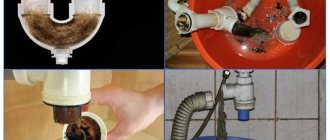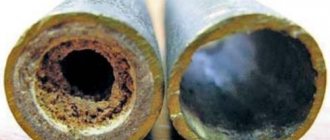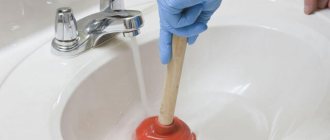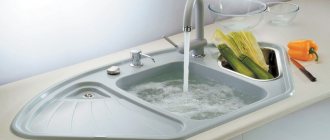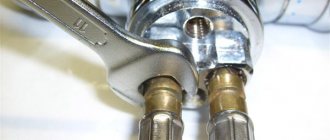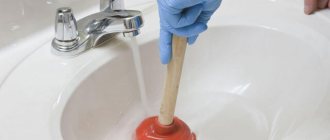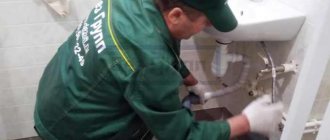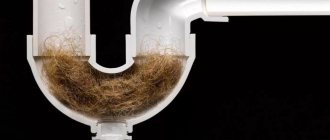Why and where exactly do clogged pipes happen in the kitchen?
The kitchen is the most visited place in the apartment: some kind of activity is constantly taking place there: cooking, eating, washing dishes. The sink is the most vulnerable place, which bears the heaviest load. It is also important to take into account that, unlike the bathroom, the drains in the kitchen are dirtier: therefore, protective nets are used on pipe outlets. If they are neglected, all kitchen waste goes straight into the sewer outlet, partially remaining on the walls of the pipes in the form of layers.
Over time, the thickness of this layer becomes so large that it leads to serious problems with the passage of water. An omen of such a situation is a slight slowdown in the flow of water from the sink into the drain. Another sign is the presence of special croaking sounds that accompany kitchen drainage: they are created by air coming from inside the system.
If there are blockages in the pipe, the flow of air slows down noticeably. If we are talking about a large plug in a pipe, then it is impossible not to notice it. In such a situation, the question naturally arises: how to break through a pipe in the kitchen?
Methods for removing blockages, how to break through
Once a blocked pipe has been diagnosed, the next step is to fix the problem. At the same time, the main thing is not to panic, because what happened can hardly be called a serious accident. It is clear that you will have to endure some inconvenience during the work to eliminate the blockage, so you need to act as quickly as possible. There are several methods for these purposes.
List of methods for eliminating kitchen blockages:
- Using improvised means.
- Mechanical method.
- Chemical method.
Each option has its own strengths and weaknesses. For example, blockages that are located deep inside the sewer system are usually removed mechanically. Only very light traffic jams can be removed using improvised means. As for chemistry, this method is quite universal: it can handle tasks of varying complexity.
When deciding what is the best way to break through a blockage in a pipe, a combination of methods is often used, since it is not always possible to clear a pipe using just one method. This leads to a noticeable increase in the effect of ongoing activities. For example, flushing the system with hot water, which is a readily available means, can be safely used in all other cases. In short, there are no strict restrictions in this case - you can do everything as long as the result is achieved.
Requirements for means for dissolving blockages
Any composition for cleaning sewers is subject to a certain set of requirements. If an industrially produced product does not comply with them, it will not be allowed for sale. There are no such strict restrictions for a homemade solution, but it is advisable not to ignore them. We will use these criteria when assessing the effectiveness of the formulations being analyzed.
Here are the requirements for means for dissolving blockages in sewer pipes:
- Efficiency. The ideal composition should remove blockages anywhere in the sewer system. Real formulations rarely achieve such effectiveness, having certain limits of applicability. Expanding the scope of application requires the introduction of potent substances into the composition, which is not always possible or justified.
- Health safety. It is advisable that the product does not burn the skin of the hands and mucous membranes. Unfortunately, this requirement directly contradicts efficiency. Therefore, it is recommended to wear protective gloves when using many recipes.
- Safety for the materials from which the pipes are made. This criterion sounds quite strict: the composition used should not destroy the cast iron and polymers from which the sewer system pipes are made.
- Availability and low price. The rarer the components are and the more expensive they are, the worse the product will meet this effectiveness criterion. It is for this indicator that homemade compositions often outperform gels, powders and solutions made in a factory.
- Easy to use. The composition should not require long exposure or use according to a complex algorithm. In addition, an ideal product should “forgive errors” when used, i.e., remain effective even if the instructions are not strictly followed.
We recommend: “Progress” detergent: composition and recommendations for use
Having decided on the principle of operation of homemade pipe cleaning compounds and formulated criteria for assessing their effectiveness, let’s move on to analyzing methods of dealing with blockages that have stood the test of time.
Available means
The list of available means consists of those substances and tools that are either already available on the farm or can be easily purchased. For example, soda, vinegar and hot water are usually found in any home. And a plunger, even if you don’t have one, can be borrowed from your neighbors or purchased at any hardware store, since its cost is low.
The simplest option is to flush the pipe with hot water, which can dissolve fats. If we are talking about steel pipes, you can use boiling water. It is better to rinse the plastic pipeline with ordinary hot tap water by opening it for a few minutes. By also introducing a plunger into the procedure, you can achieve a fairly good effect: it is better to do this after the blockage has already been softened with hot water.
other methods
Despite some effectiveness of hot water, it is not always possible to break through a blockage in a pipe in this way. In this case, you can use a self-prepared solution consisting of soda, vinegar, lemon juice and salt. With the help of soda and vinegar, in this case, a chemical reaction is provoked, while salt acts as a catalyst and solvent (for more details: “How to properly clean pipes with vinegar and soda if the sewer is clogged”).
Lemon juice and vinegar are interchangeable, vinegar is just noticeably cheaper. After mixing, the entire composition must be poured into a pipe, which has already been pre-treated with boiling water. After the solution is poured, it should be left inside the pipe for about 30-60 minutes, then rinse the sink with hot water.
Baking soda is an effective assistant in the fight against blockages
Sodium bicarbonate, or baking soda, is widely used in cooking as a leavening agent for dough. When in contact with acids, this substance produces a lot of foam. Baking soda has an alkaline reaction, which allows it to effectively fight grease and dirt. Many housewives use it for cleaning dishes, stoves, cleaning and other operations.
In the fight against blockages, the ability of soda to saponify fats due to the alkaline hydrolysis reaction is used. There are several ways to implement this reaction, which should be considered in more detail.
Compositions based on soda and vinegar
The interaction of soda with acetic acid is accompanied by the rapid release of carbon dioxide. The gas pressure forces the foam into the plug, where the soda destroys deeper and deeper layers. All this quite effectively destroys the blockage, which makes it possible to cope even with old fatty deposits.
When using acetic acid, do not forget about safety precautions. The vapors of this volatile substance can cause severe burns to the mucous membranes. Therefore, before starting work, open the window and ensure the room is ventilated. Also, find a plug in advance that can reliably block the drain hole.
The practical use of a combination of soda and vinegar is done in several ways:
- Half a pack of soda is poured into the pipe, and then 100 ml of vinegar is poured into the drain. The hole must be immediately plugged with a plug. Firstly, this will not allow caustic vapors to penetrate into the room, and secondly, it will not allow a loss of gas pressure, directing it completely towards destroying the blockage. When the reaction stops (this can be seen by the cessation of hissing; it usually takes about half an hour), the drain is washed with hot water. After 2–3 liters of water pass through the pipe, the blockage will be completely destroyed and removed from the system.
- Vinegar and soda (100 ml of acid and 100 g of powder) are mixed in a glass or clay container. After foam appears, the mixture is immediately sent to the drain hole, which is then closed with a stopper. Rinse the pipe after an hour and a half; this time is usually enough to dissolve fatty deposits.
Soda can be replaced with Alka-Seltzer effervescent tablets. 3-4 tablets thrown into the drain and filled with a glass of vinegar are enough to destroy the blockage and get rid of unpleasant odors from the drain hole.
Destroying blockages with a mixture of baking soda and vinegar can be considered an effective and inexpensive way to solve the problem. Its only drawback is the risk of burns to the mucous membranes due to acetic acid vapor. To reduce the danger to a minimum, follow technology and do not neglect safety precautions.
We recommend: Tips for using caustic soda at home
A mixture of soda and table salt
Coarse table salt has a good abrasive effect. It increases the effectiveness of using soda in combating blockages in the sewer system. In practice, these substances are used as follows:
- Soda and coarse salt in a ratio of approximately 2:3 (200 g of soda and 350 g of salt) are poured into the drain. Everything is filled with hot water (0.3–0.5 l). Then you need to wait 20 minutes. During this time, the soda will chemically dissolve the fat. To remove the blockage, the drain is thoroughly flushed with a large volume of hot water. To enhance the effect, repeat the procedure 2-3 times or use a plunger.
- Salt and soda in equal quantities (200 g each) are poured into the sink drain hole and 10 ml of acetic acid is poured. Since the reaction produces caustic fumes, the drain must be carefully plugged. After waiting for an hour, the drain is washed with hot water.
The use of table salt allows you to increase the effectiveness of using soda and eliminate the use of vinegar. However, this composition will only cope with small and relatively fresh plugs. If the deposits formed a long time ago, are thick, or are located far from the drain hole, the effectiveness of the method is reduced.
Mechanical cleaning
What to do if the pipe in the kitchen is clogged, and the time to carry out the cleaning procedure is limited? In this case, a mechanical method is used, implemented with a plunger and wire for cleaning pipes. A plunger is basically a household device that uses the principle of changing pressure in a pipe. In this way, blockages are often either completely removed or noticeably weakened. In the future, you can use the already familiar method of flushing the pipe with hot water. It does not require any special skills in handling the tool.
How to clean pipes in the kitchen if the blockages are deep enough? This is done using a special tool such as wire. It consists of a metal or wire rope, and at the end there is a kind of hook or tip in the form of a ruff. These devices are quite thin and flexible, which makes it possible to reach greater depths of the sewer system. Next, you will need to carry out rotational and translational manipulations, leading to the removal of the blockage by pushing it down the pipe.
If the cable has moved approximately two meters from the blockage, the work can be considered done: it is completed by traditional pipe flushing. To implement this method, in addition to having the plumbing cable itself, you will need certain skills, as well as information about the approximate location of the blockage. However, you can learn during the procedure itself.
Types of blockages
- The classic situation is human biological waste along with flushed water do not pass into the sewer pipe, but pour out. This indicates that your toilet is clogged.
An extremely unpleasant situation that should not be allowed to happen - A more problematic case is when the drains, instead of going along the usual route, suddenly begin to pour out through the drain hole in the bathtub and sink . Most likely, it was not your fault at all, but the riser was clogged with neighbors from the upper floors. To understand the problem, you need to interview your neighbors and find out if their toilet is clogged. If it turns out that it is the riser that is clogged, then only qualified plumbers who have permission to interfere with the operation of your sewer networks will help clear the blockage.
Chemical method
How to clean a sewer pipe in the kitchen without using a plunger and cable? This question is very relevant, since both of the above tools involve the presence of unpleasant-smelling dirt during operation. Sometimes it is easier to resort to the help of special cleaning products developed by the modern chemical industry. The choice of such substances is quite extensive, and the most famous representative of this line is “Mole”, which is sold in liquid or powder form.
To remove a blockage in a kitchen pipe using a chemical method, it is important to follow the attached instructions exactly. As a rule, you need to pour or pour the product into the clogged pipe for a certain time, and then rinse it with plenty of hot water. In this way, the issue with weak and medium type plugs is usually resolved; more severe blockages will require calling a plumber or using a mechanical method.
Selected tips
When deciding what to do if there is a blockage in the pipe in the kitchen, it is also important to consider what kind of material was used to make the sewer. For example, a kitchen drain pipe made of plastic is very often used: not every such pipeline can withstand dry cleaning or boiling water well. Therefore, in such cases it is better not to take risks. As for washing with hot water, it is recommended to carry it out both before and after work, regardless of the method used. In general, it is recommended to make it a rule to periodically carry out this procedure as a preventive measure against blockages. When implementing the chemical method, it is recommended to work exclusively with protective gloves, avoiding splashes on exposed skin.
What are blockages and the causes of their occurrence?
It may seem strange to a non-professional, but blockages also have their own classification:
- Operational blockage. With such a blockage, fat settles on the inner surface of the pipes and over time attracts not only more fat, but also small mechanical debris.
- Mechanical blockage. The cause of this type of blockage is a foreign mechanical object in the sewer system.
- Siphon blockage. The causes of blockages are different, but with this type of blockage, home siphons cease to perform their function.
- A man-made blockage occurs when there is a possible error during the installation or design of plumbing equipment.
It is worth remembering that before starting to repair a riser or plumbing equipment, you need to thoroughly know where the accident occurred.
